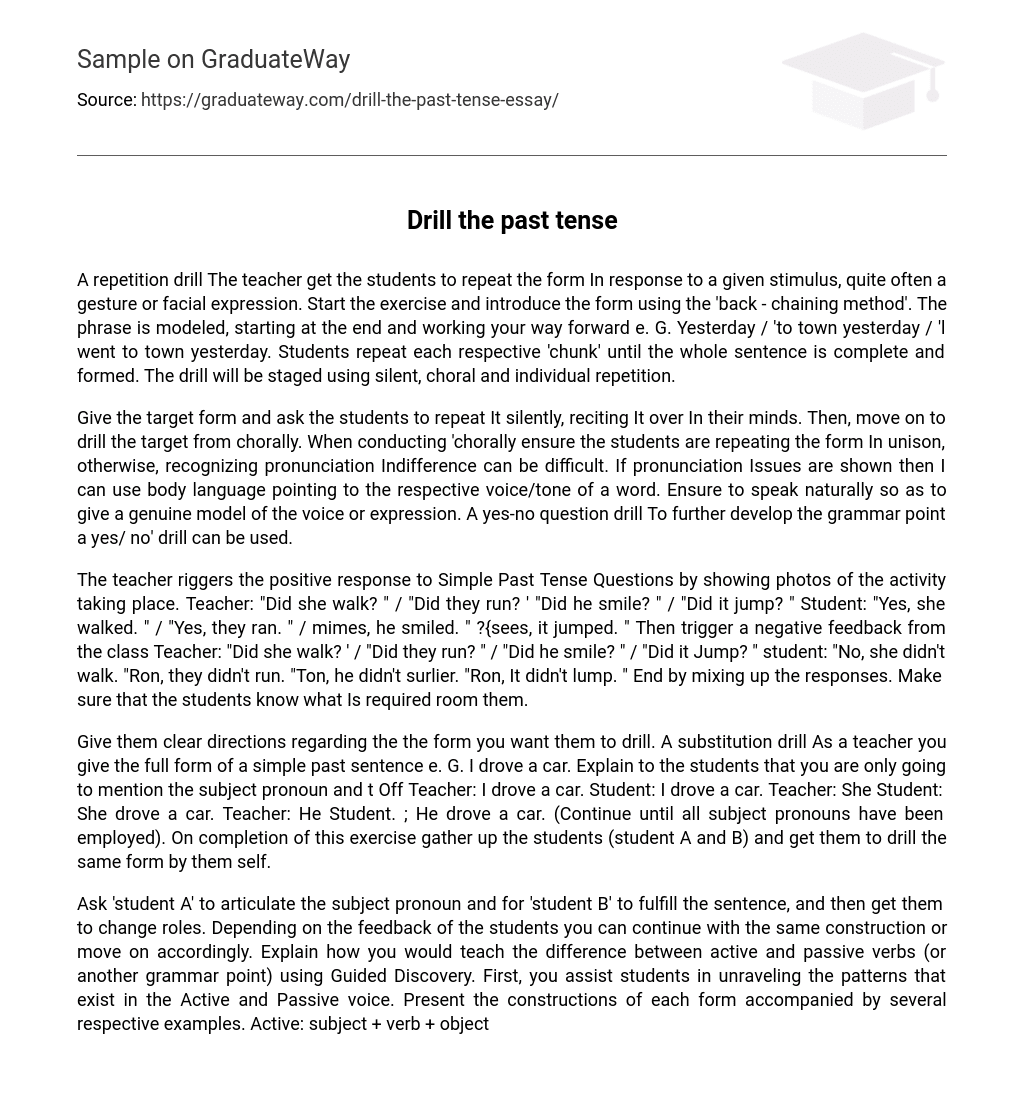A repetition drill The teacher get the students to repeat the form In response to a given stimulus, quite often a gesture or facial expression. Start the exercise and introduce the form using the ‘back – chaining method’. The phrase is modeled, starting at the end and working your way forward e. G. Yesterday / ‘to town yesterday / ‘l went to town yesterday. Students repeat each respective ‘chunk’ until the whole sentence is complete and formed. The drill will be staged using silent, choral and individual repetition.
Give the target form and ask the students to repeat It silently, reciting It over In their minds. Then, move on to drill the target from chorally. When conducting ‘chorally ensure the students are repeating the form In unison, otherwise, recognizing pronunciation Indifference can be difficult. If pronunciation Issues are shown then I can use body language pointing to the respective voice/tone of a word. Ensure to speak naturally so as to give a genuine model of the voice or expression. A yes-no question drill To further develop the grammar point a yes/ no’ drill can be used.
The teacher riggers the positive response to Simple Past Tense Questions by showing photos of the activity taking place. Teacher: “Did she walk? ” / “Did they run? ‘ “Did he smile? ” / “Did it jump? ” Student: “Yes, she walked. ” / “Yes, they ran. ” / mimes, he smiled. ” ?{sees, it jumped. ” Then trigger a negative feedback from the class Teacher: “Did she walk? ‘ / “Did they run? ” / “Did he smile? ” / “Did it Jump? ” student: “No, she didn’t walk. “Ron, they didn’t run. “Ton, he didn’t surlier. “Ron, It didn’t lump. ” End by mixing up the responses. Make sure that the students know what Is required room them.
Give them clear directions regarding the the form you want them to drill. A substitution drill As a teacher you give the full form of a simple past sentence e. G. I drove a car. Explain to the students that you are only going to mention the subject pronoun and t Off Teacher: I drove a car. Student: I drove a car. Teacher: She Student: She drove a car. Teacher: He Student. ; He drove a car. (Continue until all subject pronouns have been employed). On completion of this exercise gather up the students (student A and B) and get them to drill the same form by them self.
Ask ‘student A’ to articulate the subject pronoun and for ‘student B’ to fulfill the sentence, and then get them to change roles. Depending on the feedback of the students you can continue with the same construction or move on accordingly. Explain how you would teach the difference between active and passive verbs (or another grammar point) using Guided Discovery. First, you assist students in unraveling the patterns that exist in the Active and Passive voice. Present the constructions of each form accompanied by several respective examples. Active: subject + verb + object
Passive: Object + Conjugation of the verb to be’ + Past participle + by + Subject (Mention the truncated’ passive, a passive sentence without the by phrase as its omission can sometimes cause confusion when identifying a sentence) Give them some sentences and ask them to identify whether or not they are in the active or passive voice. The student has to observe the construction of the respective sentences (clues) and using his knowledge of the governing patterns fill out the clone exercise. Decide what the most likely grammar point will be in each of the following and summarize or define it. A.
I would go if I had the time. This is a Second Conditional Sentence. The Main clause consists of an auxiliary verb Would’ + Verb bare infinitive’ combination. The subordinate clause uses a simple past tense verb. In this sentence, the main clause precedes the subordinate clause and so the intermediate comma is omitted. The second condition tense expresses slim possibility in either the present or future tense. B. What have you done with your arm? Question word (interrogative adjective) What’ is used to refer to specific information I. E. the person asking the question Wants to know the state of this person’s arm?
Being a present perfect tense, the question makes reference to an action which has taken place at an indefinite time in the past and one which has a result in the present; that is, the hair was styled sometime in the past and continues to be styled in the present. The exact time is not important, Just the event itself. C. That car was Just painted. This is a ‘Truncated Passive Voice’ sentence. ‘Just’ indicates that the car was painted in the immediate past. The object (the car) is the intended focus of the sentence and thus takes position at the beginning.
The subject is not present; possibly because it is f no relevance to the sentence, it’s not important who painted the car, what’s important is that it has been painted. D. She could have phoned but I doubt it. This is a ‘Past Modal’ sentence using the modal verb ‘could’. The modal ‘could’ is followed by a perfect infinitive construction (have + past participle). One of the uses of the phrase ‘Could have’ is to express speculation. ‘Could have + past participle’ expresses a possible outcome, similar to ‘might have’. This combination is quite often used in the third conditional. E. She’ll have finished by the time we arrive.





